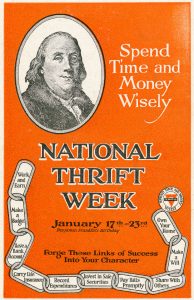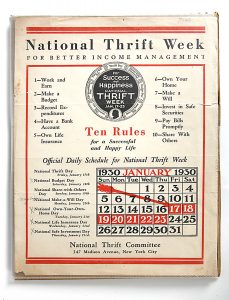
http://www.americanvalues.org
For many years, homeownership has been a piece of the American dream. In fact, 2020 marks the 100th anniversary of “Own Your Own Home Day,” which was part of Thrift Week that ran from January 17 through January 23. Each day focused on a different economic issue – Have a Bank Account Day, Invest Safely Day, Carry Life Insurance Day, Keep a Budget Day, Pay Bills Promptly Day, and Share with Others Day in addition to Own Your Own Home Day. Along with the week long campaign business organizations, including bankers, loan companies, and construction industries, drew up the “ten commandments for household finance.” Newspapers and organizations, including the National Association of Real Estate Exchanges – now known as the National Association of REALTORS®, across the country promoted the campaign. A detailed public relations plan for the week included proclamations by presidents, governors and mayors, more than 2 million posters, magazines, editorial and cartoon contests, and signs on wagons that helped spread the word about the value of responsible money management. [1] The span and creativity of the promotion is definitely notable.
Aside from being Benjamin Franklin’s birthday, January was the chosen month to observe the day because it was believed as people made New Year’s resolutions they would be in a better frame of mind to consider the future.
Following World War I and paying exceedingly high rents, Americans began considering homeownership and its economic and social benefits.
“[…] the man who buys his own home is spending his money wisely, making a sensible investment benefitting himself and his family financially, improving his moral standing and through such ramifications helping community development […]”[2] – Domestic Engineering and the Journal of Mechanical Contracting
Not only was homeownership promoted through advertising materials, but also with the help of local chambers of commerce, the Department of Labor, and realtors (before the name was a registered trademark) when they helped establish home shows.[3] It was 1919 when the [New York] Times reported plans for an exposition in New York City with displays by building and loan companies. By the following year, the show also featured model homes and lectures on domestic science and home finance. Thousands of people lined up to get into the show. In the following years, the annual show was taken over by local real estate boards.

http://www.americanvalues.org
It was not until December 1925, when the Kansas Building and Loan League shared their plans to participate in National Thrift Week, that the movement spread across Kansas. The following month, January 1926, advertising Thrift Week proved to be a huge success in Kansas. Headlines in Topeka newspapers read, “Topeka Churches Plan Thrift Week Services,” “Co-operation in Thrift Week Program Urged,” “[Gov.] Paulen Lauds Thrift Week.” In Topeka, Kansas Avenue was lined with posters promoting Thrift Week and the newspapers were filled with ads touting the importance of thrift. The Topeka Building and Loan Association called themselves “The Home of Thrift” and offered people free budget books. Beyond Topeka, Governor Ben Paulen’s Thrift Week proclamation was printed in nearly every Kansas newspaper and reports showed that approximately 100 small towns also conducted thrift programs.
Long before Thrift Week, organizations in Kansas advocated for home ownership. Dating back to the 1880s, the Topeka Building and Loan Association, a grass roots network of citizen-led thrift organizations, pooled members’ savings together to help one another buy and improve homes.
Kansans were passionate about responsible money management and living thrifty lifestyles. The principles of thrift became a part of school curriculum, even for elementary students. In 1929, Kansas Legislators participated in the effort by enacting the Kansas Credit Union Law, which supported the growth of credit unions. That summer the first two credit unions in Kansas received a charter. By 1935, Kansas had 35 credit unions with a combined membership of almost 7,000. [4]
“REALTORS® across the country, and right here in Kansas, have a long history of helping our neighbors pursue their dreams of homeownership,” said Marsha McConnell of Hutchinson, the 2020 President of the Kansas Association of REALTORS®. “Recalling the rich history of Thrift Week, and specifically Own Your Own Home Day, is a testament to the power of property ownership and the American Dream.”
Sadly, Thrift Week faded away in the 1960s although efforts
are being made to bring the observance back and once again gain national
recognition. We can still take the day to observe the many benefits of
homeownership and continue to promote its value and the American dream for the
next 100 years and beyond.
[1] Brick and Clay Record, Volume 55, 1919.
[2] Domestic Engineering and the Journal of Mechanical Contracting, Volume 93, 1920.
[3] “Own Your Own Home” Campaign Handbook, 1919.
[4] Blankenhorn, David. Kansas Thrift An Appreciation and a Proposal. Institute of American Values , 2015, http://americanvalues.org/catalog/pdfs/kansas-thrift.pdf.





